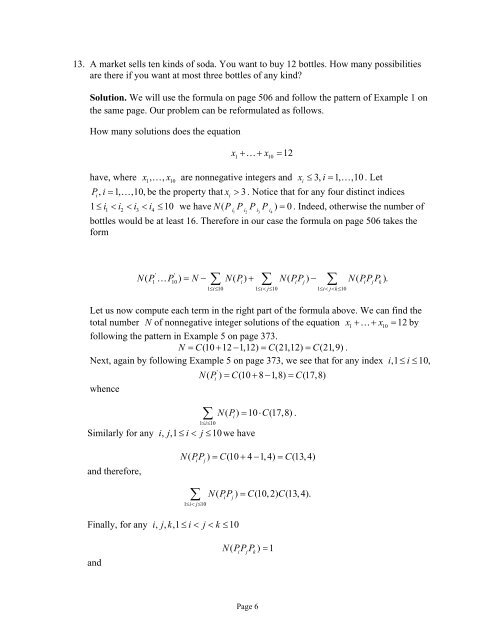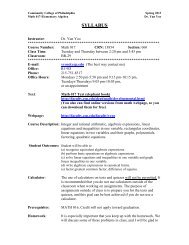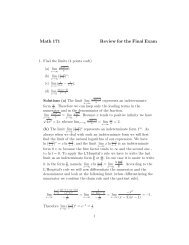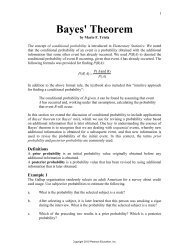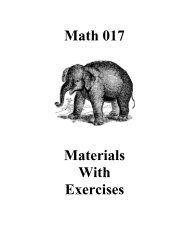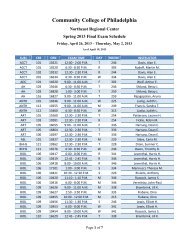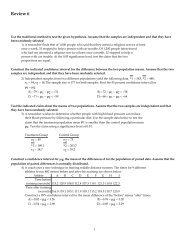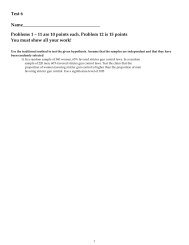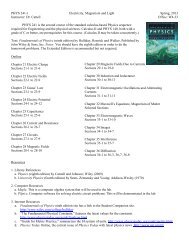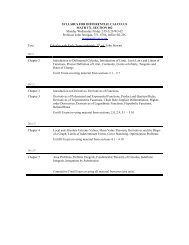163 Discrete Mathematics Review 2 Use the following to answer ...
163 Discrete Mathematics Review 2 Use the following to answer ...
163 Discrete Mathematics Review 2 Use the following to answer ...
You also want an ePaper? Increase the reach of your titles
YUMPU automatically turns print PDFs into web optimized ePapers that Google loves.
13. A market sells ten kinds of soda. You want <strong>to</strong> buy 12 bottles. How many possibilities<br />
are <strong>the</strong>re if you want at most three bottles of any kind<br />
Solution. We will use <strong>the</strong> formula on page 506 and follow <strong>the</strong> pattern of Example 1 on<br />
<strong>the</strong> same page. Our problem can be reformulated as follows.<br />
How many solutions does <strong>the</strong> equation<br />
x<br />
1+ … + x10 = 12<br />
have, where x , , 1<br />
… x1<br />
0<br />
are nonnegative integers and xi<br />
≤ 3, i = 1, …,10<br />
. Let<br />
Pi<br />
, i = 1, …,10,<br />
be <strong>the</strong> property that x<br />
i<br />
> 3. Notice that for any four distinct indices<br />
1≤ i1<br />
< i2 < i3 < i4<br />
≤10<br />
we have N( Pi P ) 0<br />
1 i 2<br />
Pi<br />
3<br />
P<br />
i 4<br />
= . Indeed, o<strong>the</strong>rwise <strong>the</strong> number of<br />
bottles would be at least 16. Therefore in our case <strong>the</strong> formula on page 506 takes <strong>the</strong><br />
form<br />
N( P … P ) = N − N( P) + N( PP) − N(<br />
PPP ).<br />
' '<br />
1 10<br />
∑ ∑ ∑<br />
i i j i<br />
1≤≤ i 10 1≤< i j≤10 1≤< i j< k≤10<br />
j<br />
k<br />
Let us now compute each term in <strong>the</strong> right part of <strong>the</strong> formula above. We can find <strong>the</strong><br />
<strong>to</strong>tal number N of nonnegative integer solutions of <strong>the</strong> equation x1+ … + x10 = 12 by<br />
<strong>following</strong> <strong>the</strong> pattern in Example 5 on page 373.<br />
N = C(10 + 12 − 1,12) = C(21,12) = C(21,9)<br />
.<br />
Next, again by <strong>following</strong> Example 5 on page 373, we see that for any index i,1≤ i≤<br />
10,<br />
whence<br />
N P C C<br />
'<br />
(<br />
i<br />
) = (10 + 8 − 1,8) = (17,8)<br />
Similarly for any<br />
and <strong>the</strong>refore,<br />
∑ N( Pi<br />
) = 10 ⋅C(17,8)<br />
.<br />
1≤≤<br />
i 10<br />
i, j,1≤ i<<br />
j ≤10we have<br />
N( PP) = C(10 + 4 − 1, 4) = C(13, 4)<br />
i<br />
∑<br />
j<br />
1≤< i j≤10<br />
N( PP) = C(10, 2) C(13, 4).<br />
i<br />
j<br />
Finally, for any i, j, k,1≤ i< j < k ≤10<br />
and<br />
NPPP (<br />
i j k)<br />
= 1<br />
Page 6


